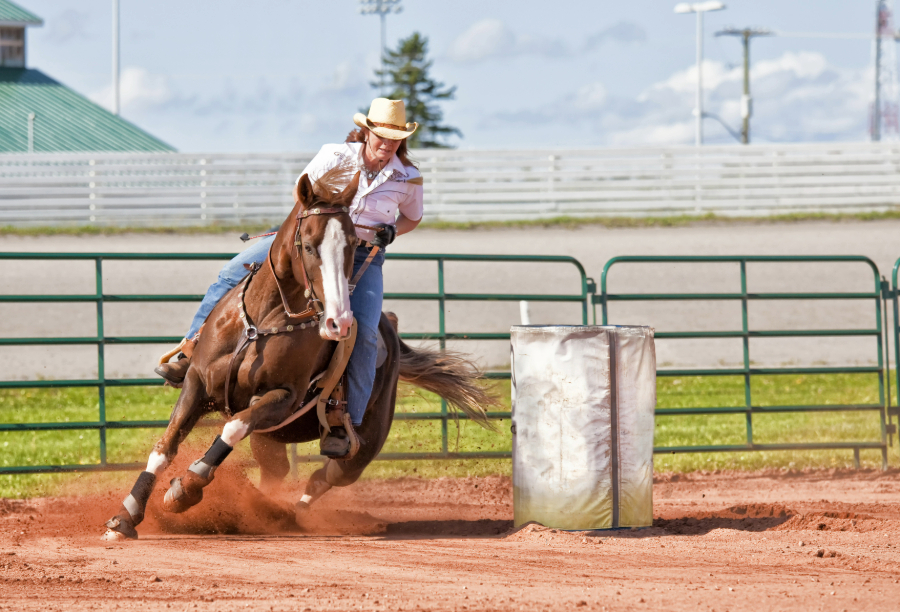Designing an equestrian arena starts from the ground up. Footing isn’t just what horses run on; it’s the key to their safety and performance success. Whether your horse is rounding a barrel at full speed or preparing to clear a jump, the arena footing plays a huge role in safety and performance.
Barrel racing and show jumping are both thrilling equestrian sports, but they have different footing demands. Barrel racing requires sharp turns, explosive speed, and a surface that can absorb the impact of rapid changes in direction. Jumping arenas, on the other hand, demand a stable base for precise takeoffs and gentle cushioning for landings.
Using the right footing for each discipline helps protect horses, improves performance, and saves money in the long run. In this guide, we’ll break down the unique needs of each discipline and show you how to create the perfect footing for your arena.
The Role of Footing in Equestrian Sports
Safety First
Footing directly impacts horse and rider safety. Slippery, uneven, or poorly maintained surfaces can lead to dangerous slips, joint strain, or even severe injuries. Barrel racers need footing that grips during sharp turns. Jumpers need a firm base to land safely.
Choosing quality materials and keeping the arena well-maintained reduces these risks.
Performance Matters
Performance begins with confidence in the ground beneath you. Barrel racing footing should support quick starts and sharp pivots. Jumping surfaces must allow strong takeoffs and gentle landings.
When footing meets the demands of the sport, horses and riders can perform their best.
Durability and Maintenance
Quality footing doesn’t just improve performance—it pays off in the long run. Lower-quality materials often wear out quickly, requiring constant repairs and costly replacements.
Investing in high-quality horse arena sand and appropriate additives creates a surface that lasts longer, performs better, and requires less maintenance. By focusing on durability, you’ll save time and money while maintaining quality footing for years to come.
Barrel Racing Footing Needs
Key Characteristics
- High Traction for Tight Turns: Barrel racers need footing that grips enough to prevent slipping during sharp turns.
- Shock Absorption for Speed and Deceleration: Protects joints from hard impacts during fast stops and starts.
- Consistent, Forgiving Surface: Uneven footing can disrupt a horse’s rhythm and increase the risk of injury. Maintaining a level, consistent surface is critical.
Popular Footing Materials
- Sand-Clay Blends: Offer a mix of grip and cushioning.
- Rubber or Fiber Additives: Add traction and reduce strain on horses.
Maintenance Tips
To keep barrel racing footing at its best, regular dragging is essential. This levels the surface, redistributes materials, and prevents compaction. Proper maintenance ensures consistent footing, reduces wear and tear on your horses, and extends the life of your arena materials.
The Unique Needs of Jumping Arena Footing
Jumping arenas focus on stability and control. Horses need footing that supports takeoffs and absorbs impact on landings.
Key Characteristics
- Stable Base: A firm surface prevents shifting, giving horses confidence during takeoffs and landings.
- Balanced Give: Allows smooth landings, reducing joint stress and preventing sudden stops.
- Excellent Drainage: Keeps footing safe and consistent by preventing pooling after rain.
Popular Footing Materials
- Sand Mixed with Geo-Textile Fibers: These blends provide stability and cushioning while holding up under frequent impacts.
- FoamFooting™: A foam additive ideal for both indoor and outdoor arena applications, providing a low-impact, comfortable ride while addressing dust issues.
Maintenance Tips
Keeping an eye out for compaction and moisture levels is crucial in jumping arenas. Dragging keeps the surface level, while watering or using moisture-retaining additives ensures consistent footing. Ensure proper drainage to prevent slick spots.
Comparing Barrel Racing and Jumping Footing
| Feature | Barrel Racing Footing | Jumping Arena Footing |
| Traction Needs | High traction for sharp, fast turns | Moderate traction for controlled movement |
| Shock Absorption | Cushioned to handle quick stops and starts | Balanced to support landings and takeoffs |
| Base Stability | Semi-loose for agility and speed | Firm for stability during impacts |
| Drainage Importance | Moderate; focus on consistency | High; critical for all-weather usability |
Understanding these differences can help arena owners make informed decisions about the materials and maintenance needed for their discipline.
Why Choose Performance Footing for Your Arena
At Performance Footing, we understand the unique needs of every equestrian discipline. Here’s what sets us apart:
- Custom Solutions: We help you find footing options designed for barrel racing, jumping, or multi-use arenas.
- Premium Materials: High-quality horse arena sand and advanced additives that balance traction, cushioning, and drainage.
- Expert Support: Our team provides personalized guidance to help you design or upgrade your arena.
- Valuable Resources: Check out our Horse Arena Footing Guide for detailed insights on creating the perfect arena.
Contact us today to get started on building an arena that supports safety, performance, and longevity.
The Foundation of a Winning Arena
Building a high-performing equestrian arena starts with understanding the unique footing needs of your discipline. Barrel racing and jumping require different surfaces to ensure safety, enhance performance, and minimize long-term maintenance costs.
With the right materials from Performance Footing, you can protect your horses, enhance performance, and save money on maintenance. Ready to elevate your arena? Visit Performance Footing today to learn more and get started.
